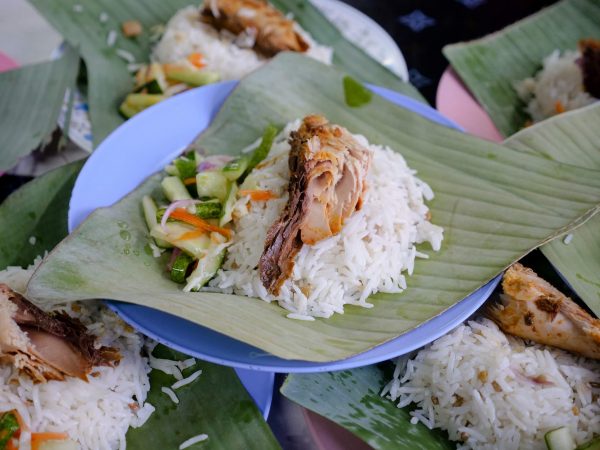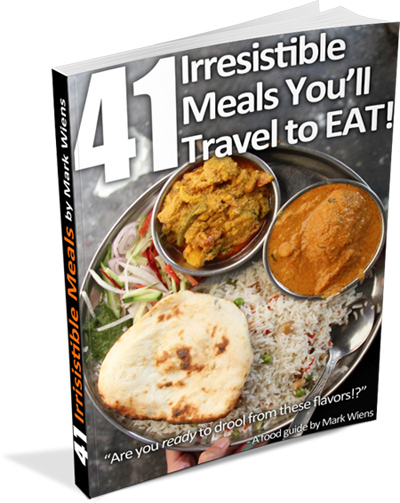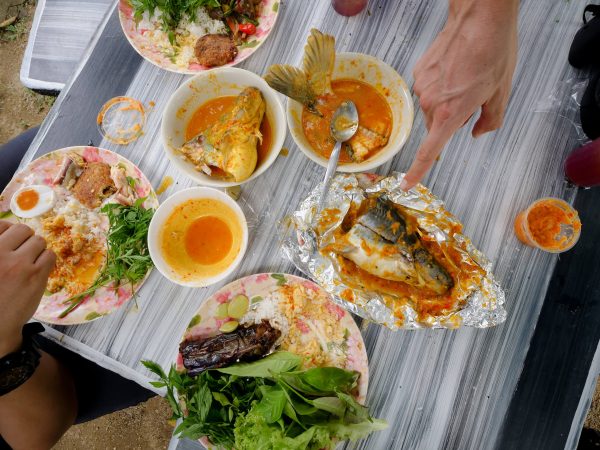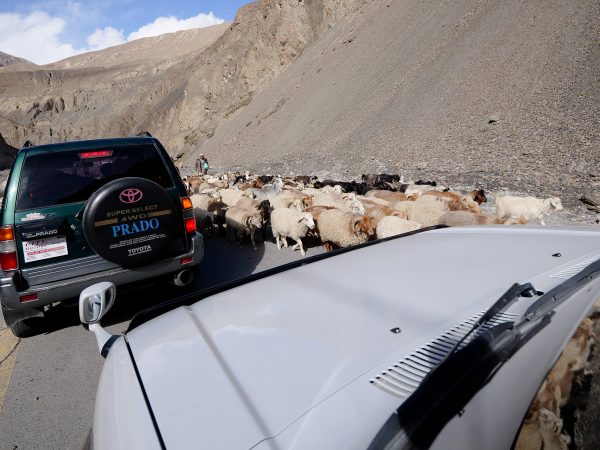
Hunza, Pakistan has one of the most beautiful landscapes in the entire world – breathtaking views I can only describe as ‘heavenly.’
If possible, your trip to Pakistan needs to include a day (or many) in the Hunza Valley.
In this article I will give you details on things to do and food to eat in one ultimate day in the Hunza Valley.
Watch the full video:
You can watch this entire day of attractions and authentic food in Hunza Valley in this video.
(Or watch it on YouTube here)

9 Things To Do in Hunza Valley (in one day)
Gilgit-Baltistan (called GB) is the Northernmost province in Pakistan. It is home to Hunza, some of the most amazing scenery on the entire earth, and a day spent there is like a day from a dream.
A complete experience in Hunza would have to include scenery, culture, some history, and of course, a lot of authentic and local Hunza food (traditionally know for its long life properties).
So let’s get started!
Here are your 9 Things to Do to make the most of your day in the Hunza Valley.
Accommodation in Hunza Valley: Thank you to Hunza Serena Inn for sponsoring our hotel accommodation stay in Hunza Valley. It’s one of the best places to stay, with great hospitality, comfortable rooms, and a spectacular view. We had a fantastic stay.

1. Rakaposhi Mountain View at Sunrise (6AM)
If I told you a story about hiking on a 6,000 meter peak, would you be impressed?
Anywhere else, I’m sure you would – but not in Hunza!
In Hunza, the mountains are so incredibly massive, most peaks under 20,000 feet aren’t even tall enough to have a name.
From the town of Karimabad, you can see three of the world’s highest mountain peaks – Bublimotin or Ladyfinger Peak (7,400m), Ultar Sar (7,500m), and the stunning Rakaposhi (7,788m).
On a clear day, look South from Karimabad town (the sun’s rays will be coming from your left), and see the towering white form of Rakaposhi looking down on the entire Hunza valley.
If the mountain peak is not visible, it is still worth waking up early, because that means more time to get excited about breakfast.

2. Eat ‘Gyal’ – A Local Hunza Breakfast (7AM)
Gyal
Gyal is a traditional local breakfast food, wheat pan-fried cakes with honey or fruit jam and the local favorite ingredient, apricot oil.
The apricot oil creates such a sweet aroma to go with the smoky flavors from the charcoal or wood used in cooking.
There are several different types of gyal, and the thing I love about this dish is how it is so simple and hearty, the perfect combination for a morning cup of buttery hot milk tea.
Local Oats (Muesli)
Honestly this is one of the tastiest breakfast foods ever, and I am not entirely sure I can name all the parts.
Almonds, Walnuts, Brown Flaxseed, and Apricot Seeds, all roasted perfectly and then ground, sprinkled over a combination of barley and a local species of wheat germ.
It is heavenly when topped off with a scoop of fresh locally made cream or yogurt and a spoonful of honey.*
Other Options
We stayed at the Serena Hotel, where the breakfast options included all of these dishes and more. If you aren’t staying at a hotel, then the Karimabad market is the most likely place to find the dishes mentioned above. If you do visit this market, also worth trying are Mantu/Mantou (a Chinese-style meat-filled wheat dumpling).
*We ate this great breakfast at Hunza Serena Inn, where they responsibly source their own organic honey, assisting local farmers in production and fair sales.

3. Climb to Baltit Fort (9AM)
Baltit Fort is a beautiful landmark of the town of Karimabad (the largest town in the Hunza Valley). Once the ruling seat of the Hunza Kingdom, it has been standing overlooking the valley for over 700 years.
It also means that this is one of the best places for an entire view of both Karimabad and the Hunza Valley.
Get exclusive updates
Enter your email and I’ll send you the best travel food content.
The climb up may be strenuous for some, remember to take time to allow your body to acclimatize to the Hunza Valley’s high elevation.
The short but steep ascent is worth it though – the views here are stunning. You are also in the perfect place to enjoy a few snacks on the way down, an immediate reward for your morning exercise.
Address: Google Maps
Open hours: 9 AM – 5 PM
Price: Free to climb, 400PKR for entrance to the museum (includes Guide)

4. Increase your Lifespan with “Hunza Water”
Expensive bottles of mineral water can’t compare to the life-giving benefits in the water that Hunza residents drink for free.
Some of the longest-living people on planet earth, scientists have named this glacial drinking water as the number one life-prolonging secret to people living in Hunza.
Hunza Water is not a joke, it comes from Himalayan-glacial melt, has an unnaturally alkaline pH-level (meaning a high pH), and “extraordinary levels of active hydrogen.” The Hunza Valley region makes this ultra-pure possible due to the remoteness of these mountains (ever remaining free of pollution).
Some other countries have now learned to ionize their water to resemble Hunza Water, perfecting things like tea ceremonies, or hospital-grade sanitation.
We enjoyed drinking directly from a glacial-stream flowing off of Mt. Rakaposhi, during the drive from Gilgit Town to Hunza Valley the day before. The water glitters like crystal, is of course icy cold, and very refreshing.

5. Snacks of Apples or Dried Fruit (10AM)
Apples and Apple Juice
Apples are probably the most famous produce from Hunza Valley, and you can see orchards reaching up the mountain sides in all directions.
They have many different varieties, sweet, crispy, tart and juicy – if you see an apply tree, try eating one while its still attached to the stem.
Not only are the apples very inexpensive here, a local friend even jokingly cautioned me on how ‘they are so good, that you might even be in danger of not wanting an apple anywhere else again.’
Dried Fruits from Hunza
This valley is sitting at a perfect altitude to grow many fruits that may often be extremely expensive in other parts of the world.
Make sure to try the locally grown almonds, walnuts, apricots, and grapes. If you want a taste adventure, look out for the very sour but delicious-smelling local species of quince (also called a ‘Queen Apple’).
Dried fruits are sold everywhere in local shops, and are a big part of the sales at the local Karimabad Market. These are also exported to larger shops elsewhere in Pakistan, so buying them here usually lowers prices. Spend 300-500PKR for large bags of dried mulberries, grapes, persimmons, walnuts, and almonds, and then anywhere from 150-350 for dried apricots, depending on quality.

6. Boat Ride on Attabad Lake (11 AM)
After lunch, you have a decision to make. If you have your own transportation, or have access to a rental vehicle, I would recommend the short trip to Attabad Lake, one of the truly majestic attractions near Hunza Valley.
If not, then simply finding a nice spot to soak up more of the valley’s stunning scenery is never a bad way to prepare yourself for lunch. Also, think about a warm beverage at Cafe de Hunza (more details below)
The Most Vibrant of All Things Blue
The stunning beauty of Attabad Lake (sometimes ‘Atta Abad’) is the result of a massive landslide in 2010. Surrounding the lake on all sides are towering steely gray rock faces, examples of the starkness of the Karakoram Mountain Range.
The lake surface reflects a color of the most vibrant blue I can imagine, a color so powerful you have to see it to believe. There is a wonderful restaurant next to a roadside viewpoint above the lake, stop here for a cup of steaming dud pathi milk tea and enjoy the panoramic lake view.
Finally, if you walk down to the lakeside itself, there are boats waiting to take you for a 15-30 minute trip around the lake.
Location: Google Maps
Open hours: All Daylight Hours
Price: Expect to pay around 2000PKR for the entire boat (can hold 15 people)

7. Have a Hearty Hunza Lunch (2 PM)
Walking outside in the brisk Hunza air is a wonderful change from the hot and humid Indus River Valley, and right about now you should find yourself quite hungry for a warming and hearty local lunch.
I recommend eating at Hunza Food Pavilion, where the amazing Aunty makes completely authentic local Hunza Valley dishes, all the cooking done in-house and done fresh. It is (usually) run by two ladies who don’t start cooking until you order, so you know that every dish is fresh.
The Aunties are quick to tell you their food is all organic, and most of the ingredients they use are actually home-grown. The cooking here is full of authentic local Hunza flavor, scroll down to learn about a few examples of local Hunza food you can try when you visit.

Dowdo (Noodle Soup)
Hand-cut noodles made from local wheat, dowdo is usually made with minced chicken meat. Adding a few slices of onion and cilantro, seasoning with cardamom and cumin, the soup itself a golden, buttery broth.
Dowdo is one of the foods you have to try during your day in the Hunza Valley. I think Hunza Food Pavilion served the best single bowl of it out of all the versions we had.
The bowl of dowdo they serve here is incredibly warming, the gently spiced minced meat smells wonderful, and I love how the broth is so buttery and creamy without being heavy.

Chapshurro (Meat Pies)
You might see advertising for this ‘Hunza Pizza,’ but I think that chapshurro is an amazing dish on its own.
Common to find it full of minced beef, actually the traditional chapshurro recipe uses spiced yak meat. The seasoning is simple, with a few additions of chopped onions, red chilies, small local tomatoes, and coriander leaves.
This dish is a wonderful example of the blending of local ingredients with cooking styles common to Central Pakistan. The piping hot, very filling chapshurro meat pies are one of the most widely-available (but wonderful) dishes you’ll find in the Hunza Valley.

Berekutz (Cheese-Filled Flour Cakes)
This cheese-filled flour cake is another hearty dish, perfect for those living and working in cooler mountain conditions.
The cheese in this recipe is from goat’s milk, and is traditionally a staple food in both Hunza and Balti cuisine.
Flour is rolled out, and apricot oil is spread liberally on each side before the cake fries lightly on a hot iron skillet. Cheese filling is added, and then another thin cake of flour is set on top, the whole cake cut cross-wise into triangles before serving.
Sometimes the ladies serving here work together, and other days they take turns cooking individually.
Location: At the entrance parking lot of Baltit Fort (approximate Google Map location)
Open hours: We went there in the afternoon, and she had already been cooking for several hours
Price: Our total bill came to 630 PKR (US$5)
Altit Fort
If you did not visit the Attabad Lake, then you might have some free time to visit the Altit Fort before your climb to the Eagle’s nest. Don’t wait too long though, because you don’t want to miss the incredible view of the sun going down over the valley.
Altit Fort lies part way up the climb to the area called ‘Eagle’s Nest.’ This was the original fort structure of the Hunza Valley, built in 1100 AD, the seat of the kingdom which moved to the Baltit Fort a few hundred years later.
If you have to choose, then I would recommend the Baltit, simply because its larger, and has a better view, but both are full of history of the Hunza Valley and its ancient kingdoms.
Location: Opposite the Pizza Pamir shop (Google Maps)
Open hours: 9:30AM-5:30PM
Price: 400 PKR per person (includes Guide)
Café de Hunza
If you’re like me, then in these chilly temperatures, you will always be looking for the next ‘something warm to drink.’
Coffee is only recently popular in Pakistan, but due to the amount of foreign tourists (usually on their way to a trek in the Karakoram mountains), coffee is available at many places in the Hunza Valley.
Serving both local and European style snacks to have with coffee, the walnut cake at Cafe de Hunza is great. Also try the local herbal tea, with ingredients native to the nearby Pamir Plateau.
Location: Near the Hunza Serena Hotel (Google Maps)
Open hours: 7 AM-10 PM Daily
Price: 80 PKR for Coffee, 240 PKR for Walnut Cake

8. Eagle’s Nest for Sunset (5PM)
This is one of those views that you will probably remember for the rest of your life, and one of the top things to do in Hunza Valley.
Climbing up to the Eagle’s Nest really takes some effort, but the view is breath-taking. Even in the sub-zero temperatures, I was in awe – a view of seemingly endless rows of razor sharp 7,000-8,000 metre high snowy peaks, I almost forgot about the chilly air.
For me it was one of the highlights of the entire trip, this is something you should not miss on your day in the Hunza Valley.
Note: It can get dark very rapidly up here, there are security guards walking around with torches, but still be sure to watch where you are going as there are several winding and unmarked paths on which to get lost.

9. Authentic Food in Hunza Valley (8PM)
There is no better way to experience the authentic local culture in the Hunza Valley than sharing a meal with a local family. I have to thank our good friend Ali, at Pakistan Travel Mart for making the arrangements, and this incredible meal possible.
Expect rounds of tea and after-dinner snacks to stretch well into the night, and this actually too turned out to be one of my favorite memories from this entire incredible Pakistan trip. I encourage you to check out the video of our experience here, or read the entire article written on this meal here.
I won’t go into all the dishes, but an amazing meal with a heartwarming welcome is how I can put it most briefly. The details though, of some of my favorite dishes from this night, are just down below.

Rose Mantu (Dumplings)
You may already have come across signs for these at small shops in the Karimabad market, these artful dumplings have a rose shape but do not contain actual rose flowers.
This is a special dish, if not store bought then people usually only eat them for special occasions, due to the time it requires to make each rose dumpling by hand.
Harissa
Pre-boiling meat, and peeling local brown wheat before mixing, chefs will tear meat (often goat meat) into strips. These strips go into a bowl with the wheat, along with healthy servings of apricot oil, and continue to cook to make a delicious and extremely thick stew.
A dish of few ingredients, this is another recipe that Baltistan eats on a day of special occasion.
Having the chance to eat local Hunza food with an amazing community of people is such a privilege, and it turns out to be – possibly even greater than the beauty of the mountains themselves – the highlight to all of us here visiting Hunza Valley.

Extra Rounds – Night Life in the Hunza Valley
If going out and sampling the local nightlife interests you, there are actually a few places in the central streets of Karimabad staying open until midnight or later.
For myself, while these aren’t personal highlights, I do highly recommend taking a few minutes to walk outside in the crisp mountain air. The air is so clean, and so thin, you can enjoy some of the most wonderful star-gazing you’ll ever see anywhere.
The high altitude, low humidity, and distance from any major city, mean that the light pollution here is extremely low. Find a dark place, give your eyes time to adjust, and let the amount of stars visible in the Hunza Valley night sky add a whole new dimension to this magical place.

Details For Travel
To finish this local food and top things to do in Hunza Valley guide, I want to share a few final details about how to travel In The Hunza Valley, and in Gilgit-Baltistan.
Safety
Part of the fun of traveling in areas like this, no matter how remote and other-worldly they may seem, is how it is still very possible to visit, and visit safely.
This area is has only recently become accessible to outsiders, even Pakistan’s own people are just starting to visit.
People are just starting to appreciate how wrongly the media portrays these areas, and many other areas like this all over the world – the people here could not be more lovely.
Road Travel
The first roads ever built to GB from the capital of Islamabad are still not even 40 years old, so by land travel there is only one route to take.
Many bus companies operate between Gilgit and the Hunza Valley, or another option is renting a car, or your own van (with driver). For a visit to the incredible glaciers throughout this region, there are also options to rent more adventure-capable vehicles.
Air Travel
We took a flight from Islamabad to Skardu, and after driving to Gilgit, went for an incredible visit to the Deosai National Park.
Alternatively, depending on the day, there are 1 or 2 direct flights daily between Islamabad and Gilgit (link here), and also flights from Islamabad to Skardu if your day in the Hunza Valley is part of a longer trip.
Note: Depending on which passport you are holding, you will likely need to sign into a local Immigration at any of the regional airport. Be sure to keep track of the arrival card (police will ask for it at road checkpoints during your stay in the GB region), and you will need it again for your departure.

Adventure Travel and Trekking in The Hunza Valley
I cannot comment personally on the trekking or adventure travel in this region, but we did see several adventurers on their way to climb the giant Nanga Parbat. Karimabad is the last stop before the week-long hike to base camp.
To get a visa, you will likely need to be the guest of a local organization (like we did with Pakistan Travel Mart), or a tour company.
Photography in the Hunza Valley
We saw many people visiting with the purpose of photographing the amazing and rare local Hunza valley wildlife. There are Markhor and Ibex, massive mountain goats, and even snow leopards for the patient and fortunate photographer.
For Drone and aerial photography, be sure to check for the latest information. In the GB Northern Province, drones and drone photography has very strict regulations.
Humanitarian Efforts in the Hunza Valley
There are many organizations, but also many single visitors and volunteers working in the Hunza Valley. We met a team of doctors visiting to promote health and healthy living awareness concerning things like water and hygiene. Here is a link to another organization working in the area.
I hope this Hunza Valley travel guide gives you some ideas, tips, and practical information for your trip to Hunza Valley and Gilgit-Baltistan.
What I can tell you with certainty about Hunza Vally, Pakistani is the scenery is otherworldly, the food is unique and refreshing, and the people will show you hospitality that will warm your heart.
Get exclusive updates
Enter your email and I'll send you the best travel food content.



